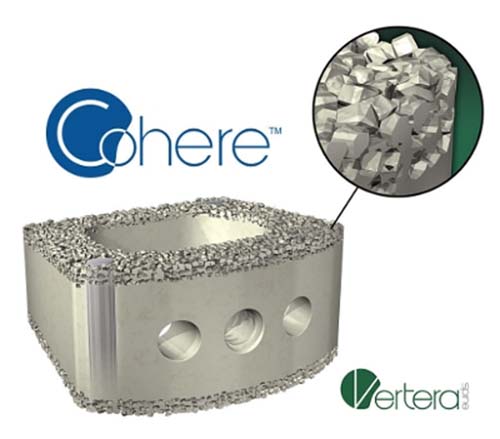
(Credit: Cohere)
Vertera Spine, a developer of medical devices using advanced biomaterial technologies, today announced the first early successful outcomes using the COHERE® Cervical Interbody Fusion Device. COHERE is Vertera Spine’s first device featuring the company’s patented porous PEEK (polyetherether ketone) Scoria® biomaterial technology. Scoria’s porous architecture seamlessly integrates with the bulk PEEK implant providing an environment for bony tissue ingrowth while retaining the mechanical and imaging properties of traditional PEEK implants. Vertera Spine will be showcasing COHERE and its Scoria technology at the upcoming NASS meeting October 26-28th in Boston, MA.
Since its initial soft launch in May 2016, over 400 COHERE devices have been implanted in anterior cervical fusion surgeries by a select number of surgeons across the United States. Dr. Robert McGuire, Past Chairman of AO Spine North America and from the University of Mississippi Medical Center in Jackson, Miss., was one of the first surgeons to use the COHERE implant.
“I have been very pleased with the early outcomes I am seeing with the COHERE device,” said Dr. McGuire. “There has been a clinical need for a porous PEEK fusion device that addresses the limited integration capabilities of traditional PEEK devices. I am excited to adopt COHERE into my practice.”
Studies have demonstrated that porous implants are able to generate a stronger osteogenic cellular response and better osseointegrate over implants with micro- and nano-roughness.1,2 While porous metal or porous metal-coated PEEK implants have found their way into spinal fusion applications, COHERE is the first device in clinical use to be manufactured entirely out of PEEK and contain porosity. Because there is no metal, COHERE also provides the additional advantage of not producing any medical imaging artifacts, allowing accurate visualization of the fusion site.
Dr. Clint Hill (The Orthopaedic Institute in Paducah, Kentucky), another soft launch COHERE user, has several several patients at 5 months post-surgery.
“COHERE with its porous PEEK architecture is the first of its kind to offer an osteoconductive environment without the use of metal. With all my patients who have received a COHERE device, I am observing early signs of fusion with significant bony bridging,” said Dr. Hill.
Likewise, Dr. Brandon Strenge, also from the Orthopaedic Institute in Kentucky, has implanted several COHERE devices and is observing similar outcomes at almost 5-months post-surgery.
“The hydrophilic nature and ingrowth capability of COHERE’s porous architecture gives me the confidence that fusion can be achieved even in more challenging multi-level cases,” said Dr. Strenge. “Porous PEEK Scoria is a game-changing technology that will make all other PEEK devices obsolete and could lend itself to many future applications.”




